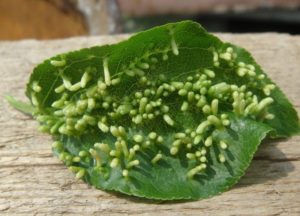Pear gall mite: means of dealing with a dangerous pest and simple tips for restoring affected plants
Every gardener dreams of beautiful and well-groomed trees. A healthy garden is the key to a future harvest. Pears are very often attacked by various pests. One of these are gall mites. Pest control is difficult. It needs to start as early as possible.
Content
Who is a gall mite
The size of the gall mite is up to 0,18 mm. You can only see it under a magnifying glass. In spring and summer, parasites have a white color, in autumn it turns into pink or light brown.
The body shape is elongated. Parasites are similar to worms. They move thanks to two pairs of legs that are close to the head. Of all fruit trees, the pest prefers pear plantings.
The life cycle of a pest
Life cycle of gall mites:
- wintering place - scales of buds and buds. Up to 1500 individuals can be in one kidney;
- at a temperature of 10 degrees Celsius, the pest enters the active stage. When opening the kidneys, females lay eggs. The population is increasing exponentially;
- after a while, the gall dries up. Adults emerge from it through cracks;
- the first generation moves through the leaves and makes numerous clutches;
- 3 generations appear during the season.
What harm does a pear mite cause
Larvae and adults feed on the juice of the kidneys and leaves. The leaves turn brown and begin to fall off. Pests are especially dangerous for young seedlings. The activity of parasites leads to the death of the culture.
In adult pears, growth stops and branches do not develop. The death of buds and buds occurs. Weakened plants cannot bear good fruit. Usually there are rotten pears on the trees. Plants are gradually depleted and weaken. They can easily be affected by fungal diseases.
Why does a pear gall mite appear in the garden
Reasons for the appearance of gall mites in the garden:
- non-observance of the distance between seedlings;
- excess phosphorus;
- untimely cleaning of the trunk circle;
- the wrong choice of chemicals that destroy natural enemies - ladybugs and dragonflies;
- incorrect pruning;
- the ability of parasites to migrate.
Symptoms of plant damage
The pest is difficult to see due to its diminutive size. The tree often has underdeveloped shoots, and on the leaves there are yellow-brown and dark swellings - galls.
Galls can be combined into large growths. Over time, they dry out and begin to crack. In this case, the parasites go to healthy leaves. Gradually, the growths completely cover the surface of the foliage, which leads to a violation of metabolic processes.
Immunity weakens and the tree is affected by diseases and pests.
Fight against gall mite on a pear
Getting rid of parasites is not easy. You can apply chemical, biological, folk methods. It is best to alternate them. Also, the implementation of prevention and agrotechnical measures will be beneficial.
Chemicals
The most powerful are chemicals. They can destroy large colonies. All chemicals are used strictly according to the instructions.
Biological preparations
A huge advantage of biological products is their safety and environmental friendliness. Many summer residents use only biological agents. Their action is not as strong as that of chemicals. However, in the initial stage of infection, they are able to eliminate parasites.
Folk ways
The most effective infusions and decoctions.
| Dandelion infusion | 1 kg of dandelion leaves is added to 3 liters of water. Insist for 3 days. Strain and add 2 tbsp. l liquid soap. Spray trees. |
| Leaf infusion | 1 kg of potato tops is crushed and poured into a bucket of warm water. Insist 4-5 hours. Add 1 tbsp. l liquid soap and sprayed plants. |
| Marigold decoction | 0,1 kg of marigolds are added to 1 liter of water and boiled. Leave for 5 days. Pour another 1 liter of water and spray the trees. |
| Pepper decoction | 1 kg of chili peppers are crushed and poured into a bucket of water. Boil on low heat for 1,5-2 hours. Leaves and crown are sprayed with decoction. |
Agricultural practices
Carrying out agrotechnical measures will reduce the likelihood of the appearance of parasites:
- purchase seedlings and cuttings from trusted gardeners;
- remove fallen leaves and weeds from the site;
- in autumn they dig up the root surface of trees;
- wood ash is introduced into the soil to strengthen immunity;
- choose resistant varieties of pears;
- remove old bark and large branches;
- fed with mineral fertilizers;
- white crowns.
Prevention of the appearance of gall mites
An excellent solution would be to carry out activities that will prevent gall mites from appearing. Preventive measures:
- moderate top dressing with mineral fertilizers;
- spraying 2% - oh Bordeaux liquid in the fall;
- timely pruning;
- planting seedlings with a certain distance;
- maintaining cleanliness in the near-stem circle;
- elimination of weed grasses;
- use of trapping belts.
What varieties of pears are resistant to pest damage
When choosing seedlings, preference is given to varieties that are resistant to gall mites. They usually don't get scab. Pear varieties:
- Red-sided;
- fabulous;
- Myth;
- Decabrinka;
- Larinskaya;
- Rainbow;
- Yellow-fruited;
- Northerner.
